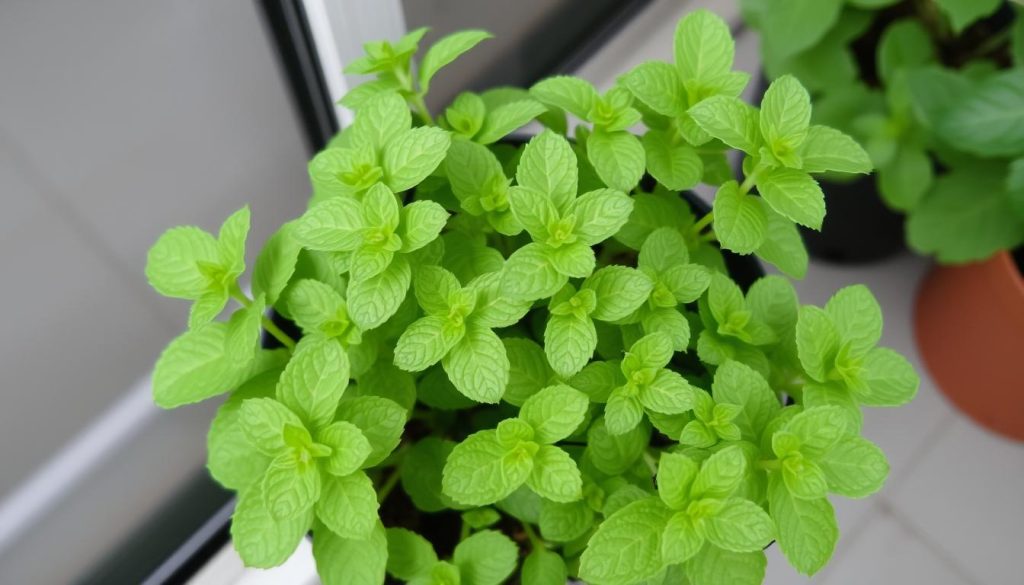Mint is a well-loved herb known for its cool aroma and many uses in the kitchen. However, it’s also known for growing quickly and spreading wide. We will share key strategies for keeping mint under control. These tips are for everyone, whether you’ve been gardening for years or are just starting out. Learn how to grow mint and keep your garden tidy.
Key Takeaways
- Understanding the challenges of mint propagation.
- Effective strategies for managing mint growth.
- Essential gardening tips to control mint spread.
- Maintaining a healthy and vibrant mint plant.
- How to prevent mint from overtaking your garden.
Choosing the Right Location for Your Mint Plant
Picking the right spot for your mint plant is key to its health. Mint is adaptable, yet careful thought must be put into its placement for best growth and control.
Sunlight Requirements
Mint loves lots of sun, needing 6 to 8 hours of it each day. But they can also do well in partial shade. This flexibility allows them to fit in many garden spaces. Getting enough sunlight ensures they grow strong and stay healthy.
Soil Conditions
The best soil for mint drains well and is full of organic stuff. It needs a pH between 6.0 to 7.0 for the best growing conditions. Make sure the soil isn’t too wet, but stays moist.
Container vs. Ground Planting
The choice between putting mint in a pot or in the ground depends on your garden and how much you want to control its spread.
| Method | Benefits | Drawbacks |
|---|---|---|
| Container Gardening |
|
|
| Ground Planting |
|
|
Either growing mint in a pot or the ground has its pluses and minuses. Knowing these will help you take good care of your mint plant.
Proper Planting Techniques to Control Mint Spread
To manage mint’s spread in your garden, specific planting methods are necessary. These techniques help keep mint’s growth in check. This makes caring for plants easier.
Using Barriers
Using physical barriers is key to controlling mint spread. Placing barriers, like plastic or metal edging underground, stops roots from growing out of bounds. These should go at least 12-18 inches deep for best results.

Using pots or containers is another great way to control mint. Ensure the pots are at least 12 inches deep. This controls the mint’s strong roots and makes it easier to manage.
Best Time to Plant
The timing is very important for controlling mint. Plant mint in spring after the last frost or in early summer. This helps the mint grow strong and makes care easier, preventing it from taking over.
Keeping up with maintenance like pruning helps control mint growth. By doing this, your mint will grow well without becoming too much to handle.
Essential Mint Care Practices
Growing mint plants well means giving them lots of care. Here’s all you need to make sure your mint does great and doesn’t spread too much.
Watering Tips
Mints really like being watered, but too much can be bad. Keep the soil moist, not soaked. Watering them well when it’s dry keeps your mint happy. It’s best to give them a lot of water once or twice a week, depending on the weather and soil.
Fertilizing Guide
Mint doesn’t need a lot of food, but a little fertilizer helps them grow strong. Use a balanced 10-10-10 fertilizer to feed them well. Just fertilize lightly once at the start of their growing season. This helps them grow without taking over your garden.
How to Control Mint Spread in Your Garden
Managing mint in your garden is key to keep it from taking over. You can do this by pruning, using ground covers, and mulching. These actions help control mint and prevent it from growing too much.
Pruning and Trimming
It’s important to prune and trim mint regularly. This helps keep its shape and stops it from spreading seeds. By doing this often, you can control its size and keep it in check. This way, mint stays healthy and doesn’t invade other areas.
Using Ground Covers
Ground covers are great for stopping mint from spreading. Planting things like thyme or decorative grasses can keep mint’s roots from growing too far. These plants don’t just help control mint. They also make your garden look better.
Effective Mulching
Mulching is crucial for controlling mint. A good layer of mulch around your mint keeps it from growing everywhere. It also keeps the soil moist. This makes your garden healthy and attractive.
Conclusion
Successfully growing mint in your garden needs careful planning and work. Choose the right spot and know the plant’s needs for sunlight and soil to help your mint grow well. Deciding if you will plant in a container or in the ground is key to controlling the spread of mint, with barriers and timing being very important.
To keep a beautiful garden with mint, follow some important care tips. Proper watering and a specific plan for fertilizing will help your mint flourish without taking over. Regular cutting and using ground covers and mulch will also help control how much your mint spreads, so your garden looks great.
Keeping your garden looking nice with mint requires dedication. By following the tips in this article, you can enjoy mint’s benefits while keeping your garden looking good. Learning how to care for mint is the first step towards a balanced and lovely garden.

